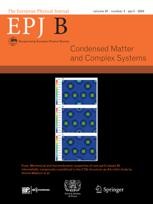Bringing consistency to methods of 2D material analysis
New research introduces a more cohesive approach to the functional renormalization group — a key tool in the analysis of 2D materials
New York | Heidelberg, 29 July 2022
 In materials science, the term “2D materials” refers to crystalline solids that consist of a single layer of atoms, with arguably the most famous example being graphene — a material made of a single layer of carbon atoms. These materials are promising for a wide range of applications including in sophisticated electronics and quantum computing thanks to their unique quantum properties.
In materials science, the term “2D materials” refers to crystalline solids that consist of a single layer of atoms, with arguably the most famous example being graphene — a material made of a single layer of carbon atoms. These materials are promising for a wide range of applications including in sophisticated electronics and quantum computing thanks to their unique quantum properties.
One of the most promising methods of investigating these materials, and specifically their temperature instabilities, and for investigating quantum many-body phenomena is the functional renormalisation group (FRG). Yet, despite significant efforts, no systematic and comprehensive cohesion exists for different momentum space FRG implementations.
A new paper published in EPJ B and authored by Jacob Beyer, Institute for Theoretical Solid State Physics, RWTH Aachen University, Germany, alongside Jonas B. Hauck, and Lennart Klebl of the university’s Institute for Theory of Statistical Physics lays out a potential groundwork for achieving consistency across FRG methods.
To do this, the team analysed three different independently developed FRG codes and achieved an unprecedented level of conformity between these implementations. They also lay out an exact procedure that can be followed by other researchers to achieve a similar analysis.
The authors of the paper point out that though a lack of cohesion in this area has not prevented the publication of relevant scientific results, however an established mutual agreement across FRG realisations will strengthen confidence in the method.
Seeing this as a first step towards a shared knowledge repository and motivated by potential application to strongly correlated states in two-dimensional materials, the researchers substantiated the reproducibility of their calculations by scrutinising pillar FRG results reported in the literature.
This allowed the team to verify the implementation of their method against established results for momentum space FRG calculations.
The team is currently working to combine their codes under a single, versatile “community code” with a polished, common, easy-to-use interface that will be available to all FRG researchers and for others interested in investigating many-body problems in physics.
Reference: Beyer, J., Hauck, J.B. & Klebl, L. Reference results for the momentum space functional renormalization group. Eur. Phys. J. B 95, 65 (2022). https://doi.org/10.1140/epjb/s10051-022-00323-y
Further Information
For more information visit: www.epj.org
Services for Journalists
The full-text article is available here.
Contact
Sabine Lehr | Springer | Physics Editorial Department
tel +49-6221-487-8336 | sabine.lehr@springer.com
